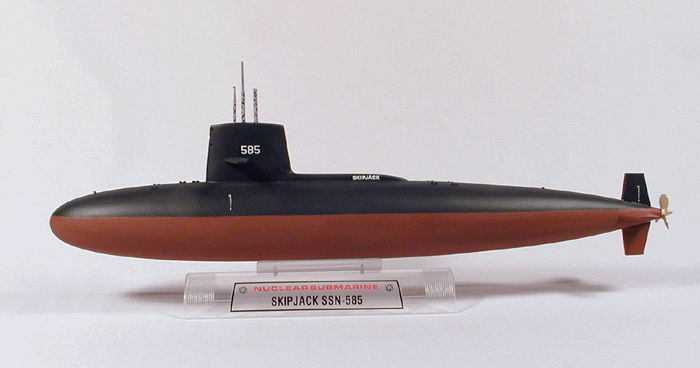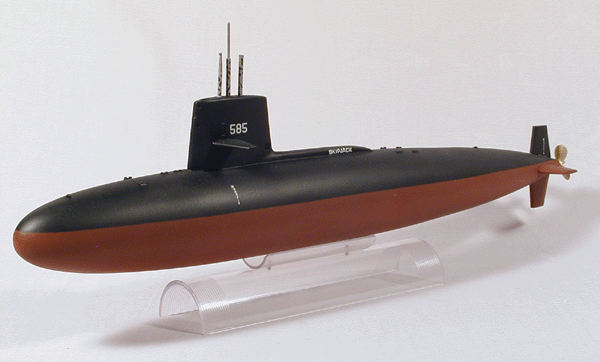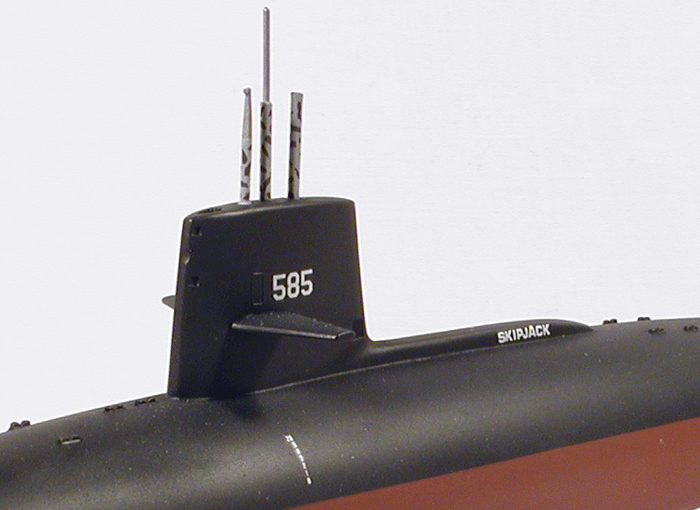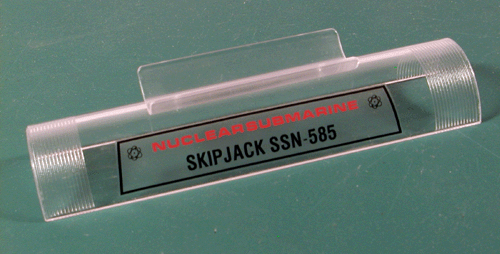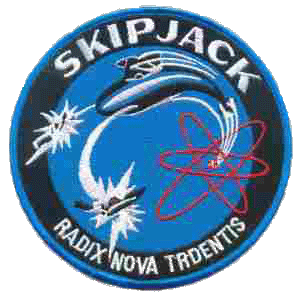SSN - 585 SKIPJACK, the U.S. Navy's first nuclear-powered fast attack submarine built on the teardrop hull concept. With a life spanning more than 30 years from commissioning (April 1959) to decommissioning (April 1990), this was one of the most significant submarines of the last half of the 20th century.
 The model pictured here is the latest release of this kit from Revell of Germany. Taken from the Aurora molds of the 1960's, this is a styrene plastic kit listed as 1:230 scale. The kit includes a lift-off hatch exposing the nuclear reactor core--a neat feature for the '60s. I chose to build mine without the interior parts accessible. Another feature common to kits of the '60s that wasn't actually appropriate was the raised detail showing hatch and panel lines. I removed these raised details to better resemble the photographs of the real submarine--and make construction of the kit easier.
The model pictured here is the latest release of this kit from Revell of Germany. Taken from the Aurora molds of the 1960's, this is a styrene plastic kit listed as 1:230 scale. The kit includes a lift-off hatch exposing the nuclear reactor core--a neat feature for the '60s. I chose to build mine without the interior parts accessible. Another feature common to kits of the '60s that wasn't actually appropriate was the raised detail showing hatch and panel lines. I removed these raised details to better resemble the photographs of the real submarine--and make construction of the kit easier.
 The hull is molded in two pieces with the division running horizontally at the centerline. This and some divots in the plastic required filling and sanding for a smooth profile. The hatch piece covering the reactor core was glued in place and also required some extensive puttying to restore the curvature of the hull.
The hull is molded in two pieces with the division running horizontally at the centerline. This and some divots in the plastic required filling and sanding for a smooth profile. The hatch piece covering the reactor core was glued in place and also required some extensive puttying to restore the curvature of the hull.
 The sail (that structure jutting up from the round hull) consisted of two halves, two planes, and three masts (the front-most being the periscope). The two halves went together cleanly with almost seam filling needed. Joining the sail to the hull left a seam gap around the base to fill. I used epoxy putty for this since I didn't want any shrinkage here and have had excellent results with similar seams on previous kits.
The sail (that structure jutting up from the round hull) consisted of two halves, two planes, and three masts (the front-most being the periscope). The two halves went together cleanly with almost seam filling needed. Joining the sail to the hull left a seam gap around the base to fill. I used epoxy putty for this since I didn't want any shrinkage here and have had excellent results with similar seams on previous kits.
 Painting the kit was an issue. The kit instructions clearly were not correct compared to pictures of the actual submarine. The scheme varied slightly during the life of the boat, with an all-black or red and black scheme separating just above the centerline being the most widely accepted patterns. A third pattern called for the red to extend all the way up to the waterline (not far below the cleats visible in the pic above), but photographic proof of this has been difficult for me to find.
Painting the kit was an issue. The kit instructions clearly were not correct compared to pictures of the actual submarine. The scheme varied slightly during the life of the boat, with an all-black or red and black scheme separating just above the centerline being the most widely accepted patterns. A third pattern called for the red to extend all the way up to the waterline (not far below the cleats visible in the pic above), but photographic proof of this has been difficult for me to find.
 I chose to use Floquil paints for the entire kit. These are a series of paints created for the model railroading hobby and are some of the best paints I have ever used. The entire model started out with a coating of gray primer. When all the now-visible seams, scratches, and divots were filled and the primer repainted a basecoat of custom-mixed red was applied. I experimented with the ratios and settled on a 16:1 of Scarlet Red and Engine Black for the red hull color. Once sufficiently dry (over night), I lightly marked a horizontal line just above the rear horizontal fins and masked below this line with standard masking tape. Floquil paints adhere extremely well, so I wasn't concerned about the paint lifting with the tape. Straight Engine Black was painted above the mask line. The masts were basecoated with the gray primer and a camoflage pattern was freehanded using Weathered Black and a fine brush. Steel silver was painted on the upper half of the periscope and the thin upper portion of the second mast.
I chose to use Floquil paints for the entire kit. These are a series of paints created for the model railroading hobby and are some of the best paints I have ever used. The entire model started out with a coating of gray primer. When all the now-visible seams, scratches, and divots were filled and the primer repainted a basecoat of custom-mixed red was applied. I experimented with the ratios and settled on a 16:1 of Scarlet Red and Engine Black for the red hull color. Once sufficiently dry (over night), I lightly marked a horizontal line just above the rear horizontal fins and masked below this line with standard masking tape. Floquil paints adhere extremely well, so I wasn't concerned about the paint lifting with the tape. Straight Engine Black was painted above the mask line. The masts were basecoated with the gray primer and a camoflage pattern was freehanded using Weathered Black and a fine brush. Steel silver was painted on the upper half of the periscope and the thin upper portion of the second mast.
 The model was given two coats for clear gloss before the decals were applied. Once set, a clear dullcoat was applied to seal the decals and give the kit the proper flat finish.
The model was given two coats for clear gloss before the decals were applied. Once set, a clear dullcoat was applied to seal the decals and give the kit the proper flat finish.
 One thing I did not like about the kit was the display stand. The two upright pieces had possibilities for scratchbuilding projects...but not here. With this in mind, I scrounged through my spare parts box and came up with a clear lens cover and a clear coin holder. I cut the coin holder down the middle and removed both ends. After a little polishing, I found the centeline of both pieces, drilled a couple of 1/16" holes in the small piece and corresponding holes in the large piece, and joined them by pressing a couple of short aluminum pins cut from some tubing into the holes I drilled. The last touch was to add the decal intended for the kit display to the base I just assembled.
One thing I did not like about the kit was the display stand. The two upright pieces had possibilities for scratchbuilding projects...but not here. With this in mind, I scrounged through my spare parts box and came up with a clear lens cover and a clear coin holder. I cut the coin holder down the middle and removed both ends. After a little polishing, I found the centeline of both pieces, drilled a couple of 1/16" holes in the small piece and corresponding holes in the large piece, and joined them by pressing a couple of short aluminum pins cut from some tubing into the holes I drilled. The last touch was to add the decal intended for the kit display to the base I just assembled.
 The shape of the new base seemed a better match for the round shapes of the submarine and the clear pieces made in less obtrusive.
The shape of the new base seemed a better match for the round shapes of the submarine and the clear pieces made in less obtrusive.
